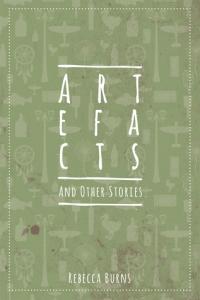 This is the third collection of stories by author Rebecca Burns, after Catching the Barramundi and The Settling Earth. Like The Settling Earth, these are short glimpses into interesting characters and situations, each one leaving the reader wanting more. Unlike The Settling Earth, the stories take place across a range of times and locations. A number of the stories are connected in some way to the two World Wars. Some of the stories look at everyday life and others explore serious trauma, and many of them weave together the extraordinary and the mundane. They focus on personal relationships, whether between family or friends.
This is the third collection of stories by author Rebecca Burns, after Catching the Barramundi and The Settling Earth. Like The Settling Earth, these are short glimpses into interesting characters and situations, each one leaving the reader wanting more. Unlike The Settling Earth, the stories take place across a range of times and locations. A number of the stories are connected in some way to the two World Wars. Some of the stories look at everyday life and others explore serious trauma, and many of them weave together the extraordinary and the mundane. They focus on personal relationships, whether between family or friends.
Each of these short stories evokes powerful emotions while at the same time leaving much to the reader’s imaginations. The title story, which takes place in England during World War II, was one of my favorites. It’s about a young woman who can hear the thoughts of others, and she’s considerably limited by this special ability. She agrees to go on a date with her co-worker, but it’s difficult for her to cope with the simple act of dinner and a movie because she’s overwhelmed by the people around her.
Leah spent her days with living ghosts. And, of course, these were days when fear walked upright, breathing and beating like a man. It shadowed the men and women entering the registry offices, adding gray depth to the queues of people waiting their turn to fill in a form, clasping hands or grinding handkerchiefs into palms.
My favorite stories had a haunting quality to them. “On This Day” tells about a man with a psychological problem that causes him to live traumatic historical events depending on what took place that calendar day.
Sundays are his bewildered days. His face is set in an expression of shock, and Ava, who has only seen him on Sundays for the past year, has given up asking him how he is or why he looks so surprised. As for as she knows, this is Richard’s normal appearance now.
What makes Burns so talented, and what makes these short stories so potent, is the visual, sensory quality of her writing. I particularly liked “Defibrillate”, about a surgeon who loses an important patient, and has to take time off to put herself back together.
She pulled the glass shut, struggling with the ancient clasp. Cold air bloomed through and numbed her fingers. Cauterise, hurry. Panic threatened to overwhelm her; thumbs strained, the the shake in her hands returned.
Or:
Her hair is raven-like and shiny, like the pelt of a bird. It is so complete and deep a color that the young man wants to touch it, to plunge his fingers into the inkpot and draw them back, dripping.
Two other stories I particularly enjoyed were:
- “The Bread Princess”, a look at how a special event to give bread to the poor changes with the generations; and
- “The Greatcoat” about the sentimental value of a shared coat during wartime.
Only one story felt unsuccessful to me — “Tide” felt a bit stereotypical, about a Louisiana family with an overweight, uneducated mother. Most of the stories left me wanting more, which isn’t a bad thing; I found myself rereading them to get a better understanding of the characters.
For those who enjoy short stories, I recommend this book, and the other works of Rebecca Burns.
Note: I received a complimentary copy of this book from the author and publisher Odyssey Books. The book was published September 30, 2017.

